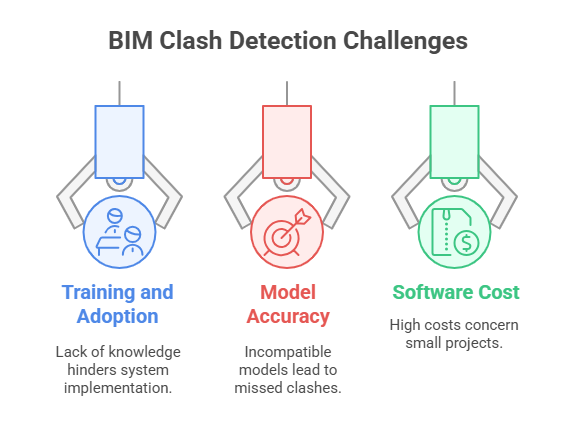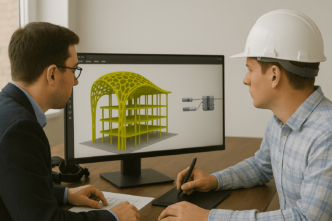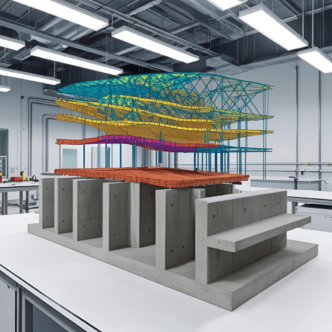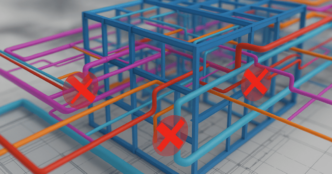In the construction industry, staying ahead of potential conflict is paramount for a seamless project execution. Conflict in construction refers to disagreements among structural, HVAC, mechanical, electrical, and plumbing (MEP) systems. These systems constitute the entire project, providing it with the diverse expertise necessary to put the execution in motion. Any conflict can put the project on hold, significantly disrupting the timeline and elevating expenses. That’s where BIM clash detection can emerge as a lifesaver. Let’s understand how BIM simplifies the MEP coordination while staying aligned with project goals.
Understanding BIM Clash Detection
Building Information Modeling (BIM) Clash Detection is primarily used for transforming the entire project into a real-world 3D environment, spanning all the elements, including design and dimensions. It enables stakeholders to see how accurately the project is executed, how many resources are left, and the time required to complete the upcoming phase. Plus, it can render a simulation of possible conflicts that may occur among different systems.
For example, it can track that a piping installation can derail the HVAC phase due to space constraints. Or, it can spot design irregularities that occur after the fabrication of a certain architectural component.
Clash detection software, like Navisworks or Revit, is among the top software used for clash detection. They can seamlessly run simulations and flag conflicts where system components overlap or interfere.
What is MEP Coordination?
MEP Coordination provides grounds for a unified design wherein the MEP system aligns with the architectural and structural framework of a building. It reinforces seamless coordination among all systems, ensuring they are aligned, code-compliant, and accessible for maintenance.
Typically, every stakeholder has access to this system so that they cannot stay aloof whenever changes occur, preventing costly delays, rework, and on-site conflicts.
Traditional coordination is tedious and time-consuming, as it requires going back and forth with 2D drawings and manual reviews, leading to misinformation, delays, inefficiencies, and redundancies.
Why BIM Clash Detection is a Game-Changer for MEP Coordination
1. Early Detection of Conflicts
One of the standout features of BIM Clash Detection is its ability to spot conflicts during the design phase. It is a kind of guiding light for stakeholders, ushering them to the correct path every single time.
It can pinpoint design differences and possible overlapping of distinctive systems.
Let’s understand this through a real-world example:
Suppose your project is halfway through and is about to kickstart a plumbing operation. But before you do that, you decide to run a quick simulation through the software, as we discussed above.
As soon as the simulation completes, you stumble upon an unexpected design flaw that can make electrical conduct intersect with a plumbing line. With this preemptive approach, the concerned stakeholders can rework their plan, saving significant money and time in the process.
2. Enhanced Collaboration Among Stakeholders
BIM Clash Detection fosters collaboration among stakeholders by facilitating key data and views at the right time, reinforcing a unified system. Additionally, it can give real-time updates concerning project progress or changes made while keeping everyone in the loop. It can significantly improve how stakeholders make decisions, no matter how complicated or sizeable the project is.
3. Improved Accuracy and Efficiency
Manual coordination of MEP systems is not a walk in the park. It requires extreme mental legwork and steadfast oversight—it is like running into a hamster wheel with no clarity on anything.
The BIM tools can fill this gap by bringing every stakeholder on the same page. Its ability to provide real-time updates and 3D simulations enables a higher level of accuracy at all stages of project development. It keeps redundancies and inefficiencies at bay, ensuring streamlined workflows from start to finish.
4. Reduced Rework and Project Delays
Construction rework is an Achilles’ heel in any project. It not only disrupts the timeline but also attracts a significant budget, hindering the cost-effectiveness.
By resolving conflicts in the virtual stage, BIM clash detection mitigates the scope for on-site modifications. It enables stakeholders to have an explicit view of project progress with optimal control over material take-off. In short, it significantly reduces rework expenses and schedule overruns.
5. Better Design Optimization
The combination of precision-driven clash reports and 3D views enables project teams to optimize the layout of MEP systems. This paves the ground for improved space management, seamless maintenance access, and enhanced energy efficiency.
6. Compliance and Risk Mitigation
BIM tools support a wide range of building codes and safety standards, including local and international regulations. Thus, they can be configured based on the project’s location. Automated clash detection can prevent stakeholders from committing expensive mistakes when it comes to ensuring the building’s safety.
Also Read: Role of BIM Coordination Services in Reducing Project Costs and Delays
Challenges in Implementing BIM Clash Detection

Projects seeking to adopt BIM clash detection may come across the following pitfalls:
Training and Adoption: Using BIM tools and understanding processes require a unique skill set and acumen. Stakeholders with little to no knowledge can fall flat when implementing these systems. That’s where a third-party service page can come in handy.
Model Accuracy: Clash detection accuracy significantly depends on the installed BIM model type. Selecting a dated or non-compatible model can lead to missed clashes.
Cost of Software: While implementation may not be a big issue, the cost of BIM tools can make small projects worry.
Struggling with BIM adoption? Request a free consultation today!
The Future of MEP Coordination with BIM
The construction industry is increasingly using advanced technologies, like BIM clash detection, to keep reworks and inefficiencies at bay. As the demand for these systems continues to rise, we will see new advancements along the way, offering enhanced features and accuracy.
The use of robotics and cloud-based collaboration shall reach to the newer heights, offering all types of projects easy access and enhanced performance.
Additionally, the use of AR/VR simulations shall further redefine how stakeholders spot intricacies and pitfalls within the projects, paving the way for timely and compliant construction
Conclusion
BIM Clash Detection plays a crucial role in boosting MEP coordination among all stakeholders. It is nothing short of a revolution for the construction sector, offering benefits that redefine how a project is designed, planned, and executed. It provides for minimal waste and prudent use of resources, ensuring significant cost savings for budget-conscious projects.
Looking for an expert BIM partner to drive your next project? Contact us now and discover how we can help!







